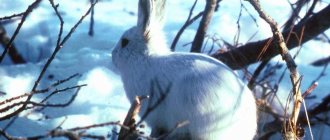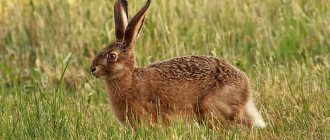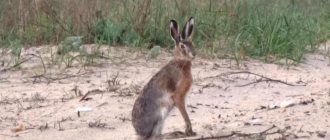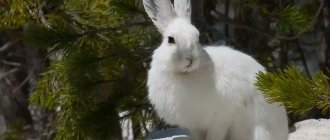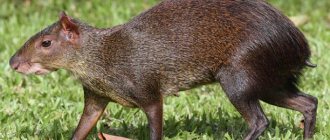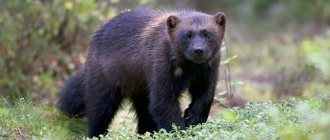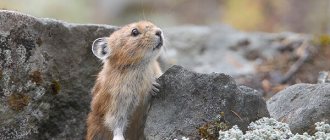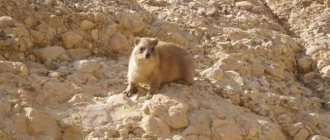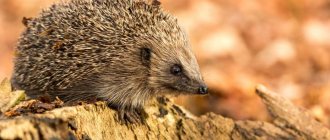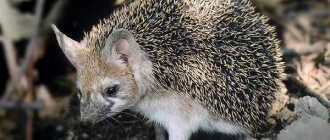- Wild animals
- >>
- Mammals
One of the most beloved characters in folk tales is the common hare . He is a little cowardly, boastful, but at the same time incredibly fast and savvy. The people did not take all these qualities “out of thin air,” but spied them from nature itself. After all, a hare is a truly smart and nimble animal, which, although it is a tasty target for large predators, is still not as harmless as it seems.
Appearance
The color of the brown hare is ocher or gray. The fur has specks of dark color, which are created by the ends of the hair. The animal's cover is silky, the side of the body is lighter than the fur on the back. The hare's belly is white. The spots around the eyes are the same color. The ends of the mammal's ears are black. In winter, the hare sheds and its new fur is noticeably lighter than its usual color, but the covering on its back and ears remains the same color even in winter.
Shedding usually occurs in the fall. However, animals can shed in the spring, at the very beginning. This difficult period lasts about 4 months. The most active molting period is April. This is when the fur falls out the most, from the hair on the head to the hair on the tail. In the autumn, the summer look is almost completely replaced by a more beautiful winter one.
Lifestyle
They live alone for most of the year, and only briefly unite into families during the breeding season. The hare is nocturnal. With the onset of darkness, he goes out to look for food, and during the day he rests, trying not to catch the eye of forest predators.
Rusaki is so well camouflaged that it is difficult to notice him, even when in close proximity to him. He does not like permanent holes; he always looks for a new place to rest. In summer, it sleeps in shallow holes surrounded by bushes or tall grass, finds empty badger or fox holes, and sometimes just rests under a bush.
In winter, the long-eared animal makes a hole for itself right in the snow, in a place protected from the wind. Hares are cautious and quiet animals. They make any sounds only in exceptional cases. When in danger, they squeak loudly and shrilly.
Rusaks can notify each other about the appearance of an enemy by drumming their paws on dry ground. Using this unusual method, reminiscent of Morse code, they manage to hide from predators.
Similarities with hare
This species has few similarities with the hare. They are both representatives of the same genus of hares. The lifestyle of these species is predominantly sedentary and they eat only plants. Animals also do not store food for the winter. Molting in hare and hare occurs 2 times a year.
If you want to find out in more detail how the brown hare differs from the white hare, then we have a whole article on this topic -.
Hunting
Hare hunting is popular in our country. This animal is an object of fur trade and sport hunting. Large quantities of these animals are hunted for their fur and tasty, nutritious meat.
Hunting begins in October before snowfall and lasts throughout the winter. There are many ways of hunting: by tracking, in blinds, in powder, with dogs and “in the wild”.
The scythe has many enemies in nature besides hunters. It is hunted by birds of prey, wolves, lynxes, coyotes and foxes. High fertility helps these animals maintain their numbers.
Lifestyle, behavior
Usually the brown hare leads a sedentary lifestyle. If the food supply is good, then the hare’s habitat does not change and is approximately 30 hectares. Otherwise, they migrate from their sleeping area to the area where they feed. Thus, the animal travels several tens of kilometers every day. Seasonal migrations occur in winter and autumn, then the hares come closer to cities and villages, come to the outskirts of the forest and to areas where there is the least snow.
Mammals that live in the mountains descend lower in the autumn, closer to the floodplains. However, by the beginning of spring they return. If the weather leaves much to be desired, for example, there is too much snow, then animals leave their habitats en masse. In the south, hares do this in the summer. Migration occurs because people begin to conduct active economic activities. Browns are more active at night and early in the morning. When the rut begins, all individuals are active.
During the fattening period, the animal covers kilometers, but individuals living in open areas travel much more than those living on the edges and in thickets. If conditions are unfavorable at this moment, hares usually do not go to fat. In the summer, the resting place is a hole that is hidden behind bushes or trees, but often the hare lies down to rest in the boundary.
Browns do not create permanent burrows, but they can dig temporary ones in case of heat. Sometimes they can rest in the norms of other animals such as badgers and foxes. The location of the burrow directly depends on the season and weather. In the spring, hares often settle in a warm place, and during rains they prefer to rest in dry areas. During the winter season, they lie in poorly ventilated places.
In regions where the snow cover is deep, hares usually create burrows 2-3 meters deep. During cold periods they like to lie down right in the hay.
Social structure and reproduction
Photo: Brown hare in the steppe
Sexual maturity of females and males of the hare occurs a year after birth, usually in the spring. This species is a fast breeder. The beginning of the rutting period and the number of broods per year depends on climatic conditions. Under favorable conditions, the mating period begins as early as January.
Rut marks are especially noticeable in the snow. These are traces of orange urine of females and blown up snow, which is trampled by angry males in a dispute over the female sex. Each female is followed by 2-3 males. They have rather tough fights, which are accompanied by their shrill screams.
The fight stops the moment the female assumes a mating position. The strongest male covers her, and the rest at this time jump over this couple, trying to knock the male down with their paws. In such conditions, only the most dexterous and strong are able to become the successor of the hare family. The next rut begins in April, followed by the third in mid-July.
The first hares will appear in April, 45-48 days after fertilization. Usually from 1 to 9 babies are born. They are born sighted, hearing and covered with fur. The weight of each bunny is about 100 g. The quantity and quality of litter is directly related to weather conditions. The warmer and more nourishing the year, the larger the hares and the greater their numbers.
For the first two weeks, the babies eat only milk, but when their weight grows 4 times, the hare begins to carry grass for them. The female does not move far from the offspring, ready in case of danger to protect her family. The family stays together until the hares are 2 months old. The mother then leaves them to attend to the next brood.
There can be 3 or 4 broods in total per year. The further south the habitat, the greater the chances of a fourth brood. The hare has enviable fertility. However, of all the babies, only 1-2 survive per year. Their mortality rate from bad weather, disease, human activity and predators is very high.
On average, hares live no more than 8 years; in rare cases, they can live 10-12 years. They have a lot of potential enemies. As a rule, they are loners and seek company only during the rut.
Habitat of the hare
This species began to conquer the north around the Quaternary period, but now the animal can be found in the tundra and steppes of Europe, in Scotland and Turkey. Hares also live in New Zealand. In Russia and Kazakhstan, mammals live almost everywhere, in Transcaucasia and the Pavlodar region, in Karaganda and the Urals. Rusaks have also adapted to living in the Far East.
Animals love to live in open spaces. These include fields and meadows, burnt areas and forest edges. Most often they can be seen deep in deciduous forests, near agricultural plots and ravines.
Natural enemies
Browns are quite defenseless and serve as easy prey for many predators. Their natural enemies include foxes, wolves, lynxes, stray dogs, hawks, eagle owls, eagles and cats.
To survive, steppe hares camouflage themselves between fallen trees, branches and snowy plains. Thanks to the color of their coat, they easily pretend to be stumps or hummocks crushed by snow.
Steppe hares are small, long-eared animals widely distributed across all continents. In some countries, hare are considered pests that can cause considerable damage to agriculture, in others they are the object of sport and commercial hunting.
We recommend the article “How long do wild hares live?”
Brown hare diet
In summer, hares eat plants and like to feast on young shoots. They can also eat tree roots. In the second half of the season, they eat seeds, which are difficult to digest. So animals spread them everywhere. So, the food mainly consists of dandelion and chicory, clover and buckwheat. Rusaki love apple and maple trees; their animals eat them with particular tenacity. Hares also eat cereals. In winter, hares dig fruits out of the snow and consume rags and seeds.
Nutrition
This mammalian herbivore is not too picky about food. The main thing for hares is that it is there. Any field plant serves as a delicacy for them. Moreover, hares can eat it whole, right with the roots. Long-eared animals living near populated areas often raid people's gardens and eat their favorite carrots and cabbage.
In the winter season, tree bark, plant seeds, and various remains of fruits and vegetables are used. Winter wheat, which they find under the snow, also saves them from starvation.
When visiting garden plots, hares sometimes cause irreparable harm to gardeners. Their favorite tree is the apple tree; it always suffers more than all other fruit trees.
An interesting fact is that hares are not always forced to gnaw apple trees by hunger. Animals constantly grow teeth, which they try to grind down on hard surfaces. This way you can have a snack at the same time.
Hares often have poor digestion of rough food, so they often feed on their own droppings, which helps them better absorb the necessary substances.
Interesting Facts
- The breeding season of these mammals lasts more than six months: from early spring to autumn. Almost all females have four litters during this time.
- Females bear offspring for approximately 45-50 days.
- Bunnies are born sighted and weigh 100 grams.
- A month after birth, the cubs already gain complete independence.
In zoological parks, cuffs are often born - hybrids that appear when white hare and hare mate.
Color
Representatives of this breed have a beautiful wavy, silky coat. A distinctive feature of the brown hare is its color. It combines an indescribable mixture of various fawn, yellowish-gray, and red tones with noticeable ripples, which especially stand out on the back. The fur in this place curls up and becomes like good merlushka (that’s what lamb’s fur is called). Please note that the brown hares living in the southern and western regions of the former Soviet Union do not change color throughout the year. In the northern regions and to the east, hares only turn slightly white, mainly on the sides. At the northern limit in winter, hares become almost white, only a dark stripe on the back remains. The tips and trim of the ears, as well as the upper part of the tail, always remain black.
How do hares prepare for winter?
While the warm period of the year lasts, hares have no problems with food. They can always profit from:
- berries;
- greens;
- vegetables;
- healthy herbs (hares love clover, yarrow, alfalfa, dandelions, sedge).
Mushrooms are also included in the diet of hares. And the fruits of fruit trees growing in the forest are a real treat for the animals. As a rule, these are wild apples and pears. Blueberries and lingonberries also add essential vitamins to the rabbits' diet.
In autumn, hares do not fall asleep; they have no time to sleep for a long time, because there are so many predators around. The preparation of animals for winter is quite active:
- They change their colored fur to white.
- They gain weight and store up calories for future use.
Interesting! In nature, hares live 8–9 years. When kept at home, they live 1–2 years longer.
Is a hare a rodent or not?
Lagomorphs differ in blood composition from rodents.
Another distinctive feature is the structure of the teeth. Hares have incisors in the upper jaw, 2 pairs on each side. The inert palate is a bridge connecting the right and left molars. In rodents it is in the form of a complete bone platform. There are no gaps between the protruding parts of the upper and lower teeth, allowing for better processing of food.
Agouti, the so-called humpbacked or golden hare, is considered a rodent.
Habits
Despite its large size, the brown hare is capable of reaching very high speeds - up to 60 km/h. However, we note that he can move at this pace for a relatively short time. While running, the hare performs long jumps and abruptly changes direction. He masterfully knows how to confuse his tracks, run in large circles, meandering through the terrain, thereby misleading his pursuers. Thanks to this method of movement, the animal manages to escape from the predators pursuing it.
Many people are interested in the question of whether hares can swim. Surprisingly, although these animals do not like water and most often stay away from it, they are quite good swimmers. The hare is practically a voiceless animal and even during the mating season only occasionally gives voice. Only when wounded does the hare scream loudly, the sound resembles the cry of a baby.
Shedding
Like all representatives of the hare family, animals experience seasonal molting twice a year - in spring and autumn. The beginning and duration of this process are related to external conditions. Molting occurs after a change in daylight hours, and its duration depends on air temperature. Spring molting begins at the end of winter or the very beginning of spring and continues for 75-80 days. Shedding begins from the head and ends at the level of the lower limbs. Shedding in autumn, on the contrary, begins at the back of the body and gradually moves to the head. Most often, it begins in September and ends at the end of November. By winter, the fur grows thicker, more lush, and it perfectly protects the animal from the cold. Molting completely changes the image of a brown hare, which allows it to better fit into the surrounding nature and be less noticeable to its enemies.
How many years does a wild hare live?
Males live on average 5 years, females up to 9 years. A tamed hare lives much longer.
The type of eared animal has an impact on the number of years lived. So, a white hare can live up to 17 years. Such cases are unique. Browns live much shorter lives, usually 5 years. Very rarely live to 14 years.
The American hare lives on average 7-8 years. The black-tailed hare lives up to a maximum of 6 years, but often representatives of this species die much earlier from disease or predators. The lifespan of an agouti (or, as they are also called, a golden or humpback hare) can reach 20 years.
The bearded seal lives for approximately 30 years; males often only live to be 25 years old.
What does a hare eat?
Hares belong to mammals and eat food of plant origin.
Brown hare food:
| Season | Food |
| Summer | Shoots of bushes, trees and plants. Foliage, stems, and roots are eaten. |
| August | Vegetables from the fields, seeds; wild plants |
| Autumn | Hares eat fruits and berries in the forest |
| Winter | Dried grass; vegetable residues; snow seeds; tree bark |
| Spring | Fresh grass |
White hare diet:
| Season | Food |
| Summer | The white hare feeds on the green parts of plants; field oats; blueberries, mushrooms; horsetails |
| Autumn | Small branches of bushes |
| Winter | Bark of trees and shrubs, shoots; rowan fruits; hay and cones. Hares eat from trees: maple, birch, aspen, oak, willow |
| Spring | Green parts of plants; grass; the soil |
The humpback hare feeds on fruits and other parts of plants.
The bearded seal eats benthic invertebrates and bottom fish: flounder, cod, and goby.
